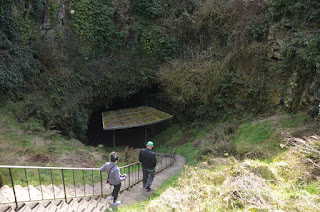We awoke this morning in Kilkenny, which boasts the nickname
of “Ireland’s Tidiest Town”. Since we
had gotten in after everything closed yesterday, we wanted to explore our
surroundings. We started at Kilkenny
Castle, which is probably the nicest and most completely restored castle that
we will see in Ireland.
As with many of
the structures we’ve visited, it had multiple incarnations: it was a 12th
century fortress, a 17th century chateau, and a 19th century
stately home. The current castle only
has three walls, forming a U-shape. It
had a south wall that was destroyed by the forces of Oliver Cromwell, but I
actually like it this way. It is far
more welcoming to its visitors and opens up onto its massive and perfectly
maintained grounds, which all the locals use to walk their dogs and stroll with
their strollers. The castle has been
owned by the national conservation society since the 1960s, when it was handed
over for a nominal sum of 50 pounds. It
had been vacant for nearly half a century before that, though, with almost all
of its contents auctioned in the 1920s.
After seeing the renovated version, however, it was hard to believe that
the walls had gotten so bare. The castle
was beautiful, with hand-painted wallpaper from China and yellow silk wallpaper
from France, hundreds of paintings hanging in the various rooms, and vast
marble fireplaces. Interestingly, during
the restoration they were able to find receipts for some of the original items
that had been removed and tracked down the companies that made the items… only
to find that they still had the designs on file from the 17th
century and could replicate their prior work.
Josh and I also learned that there were special display cases in sitting
rooms to show off one’s expensive tea and special screens by the fireplace to
prevent the wax makeup from melting off the guests’ faces. I’m so glad that thick gobs of lead-laced wax
is no longer how we’re expected to adorn ourselves.
After the castle, we wandered up the road to St. Canice’s
Cathedral.
Canice is a home-grown saint
of Ireland and the site of her cathedral has hosted over 1500 years of worship,
though the stone cathedral wasn’t started until 1202 (so young!). Early on, monks here lived on porridge, nuts,
and berries. Once they were declared a
royal monastery, however, the offerings improved immensely and they feasted on
salmon and fine wine. The round tower of
the monastery is apparently a sign of prestige and boasts the best views of the
city, though they were installing a hand rail today (I hope pre-emptively
rather than in reaction to a tragedy), so we did not get to appreciate the
vantage point.
The self-guided tour of the
cathedral, though, is fun and highlights some rather interesting history. In a shout-out to Americans, they even note
that the great great grand-uncle of President Obama is buried there.
About a block from the cathedral is the Black Abbey, which
(for tourist purposes) is basically one church.
What a church, though. Stained
glass probably decorates about 30% of the wall space, sometimes extending all
the way from ceiling to floor. In the
midday light, it set the whole church aglow.
Unfortunately, midday also meant the end of our time in
Kilkenny. The town grew on us as we
stayed there; it had just enough of everything: food, history, entertainment,
street markets, friendly strangers. Still,
our wanderlust beckoned us to our stop: Dunmore Caves.
The caves are the oldest in all of Ireland,
though once there we learned that there are actually quite a view caves eroded
into the limestone deposits around the country.
We descended over 700 steps down into the cavern, whose arched mouth
opened up about 3500 years ago, revealing the existence of the cave system.
The caves were dark, drippy, and chilly, but
it was very cool. In particular, it was
interesting to see how dynamic they were. We could see where the drip drip drip
from the ceiling was indenting the paths or building up small stalactites. From the guides, we learned that the
thousands of tiny stalactites hanging from the ceiling were each 6 mm in
diameter because that was the width of a single drop of water.
We also learned that this cave is the only
one mentioned in ancient Irish poetry, where it was called the gateway to the
land of the dead, the lair of a giant cat-like monster, and the location of a
massive slaughter. The last attribution,
it seems, is true; the Danish Vikings massacred the Dublin Vikings around 928
AD and their remains were found in the caves.
History was terrifyingly violent.
This formation is called "The Buffalo"
After Dunmore, it was on to Limerick for our lodgings. We explored the city on foot, sampled some
local pub cuisine (Irish stew!), got served our tap water in an old Irish
whisky bottle, and managed to catch the Liverpool-Manchester United game in a
pub alongside some fairly rowdy locals.
Achievement unlocked!
Fun fact: 5 species of bats live in the Dunmore Caves. They hibernate 5 months a year, lowering
their body temperature from 37 to 10 degrees Celsius and their heartbeats from
100 to 5-20 beats/minute.
Spotted: Very thick hedges!
These (unnatural) natural fences are everywhere and SO THICK. From the passenger seat of the car as we
drive on narrow, windy roads, I have gotten uncomfortably close to these hedges
and can vouch for their incredibly density.
Spotted #2: Our first Irish rainbow! We tried to follow it but, alas, it got away!










No comments:
Post a Comment